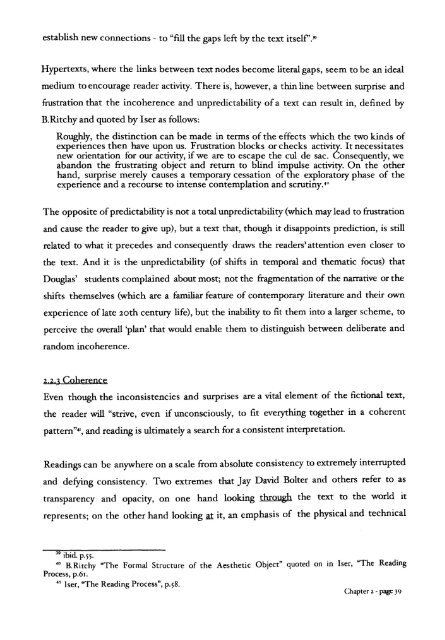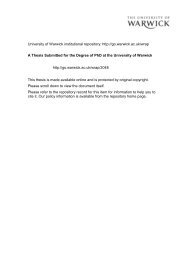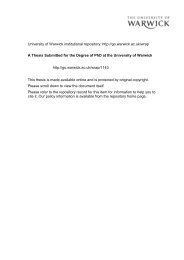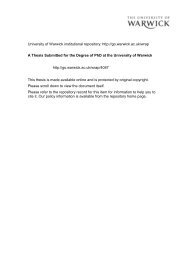From Page to Screen - WRAP: Warwick Research Archive Portal ...
From Page to Screen - WRAP: Warwick Research Archive Portal ...
From Page to Screen - WRAP: Warwick Research Archive Portal ...
You also want an ePaper? Increase the reach of your titles
YUMPU automatically turns print PDFs into web optimized ePapers that Google loves.
establish new connections - <strong>to</strong> "fill the gaps left by the text itself"."<br />
Hypertexts, where the links between text nodes become literal gaps, seem <strong>to</strong> be an ideal<br />
medium <strong>to</strong> encourage reader activity. There is, however, a thin line between surprise and<br />
frustration that the incoherence and unpredictability ofa text can result in, defined by<br />
B.Ritchyand quoted by Iser as follows:<br />
Roughly, the distinction can be made in terms of the effects which the two kinds of<br />
experiences then have upon us. Frustration blocks or checks activity. Itnecessitates<br />
new orientation for our activity, ifwe are <strong>to</strong> escape the cul de sac. Consequently, we<br />
abandon the frustrating object and return <strong>to</strong> blind impulse activity. On the other<br />
hand, surprise merely causes a temporary cessation of the explora<strong>to</strong>ry phase of the<br />
experience and a recourse <strong>to</strong> intense contemplation and scrutiny.4°<br />
The opposite ofpredictability is not a <strong>to</strong>talunpredictability (which may lead <strong>to</strong> frustration<br />
and cause the reader <strong>to</strong> give up), but a text that, though it disappoints prediction, is still<br />
related <strong>to</strong> what it precedes and consequently draws the readers) attention even closer <strong>to</strong><br />
the text. And it is the unpredictability (of shifts in temporal and thematic focus) that<br />
Douglas' students complained about most; not the fragmentation of the narrative or the<br />
shifts themselves (which are a familiar feature of contemporary literature and their own<br />
experience of late zoth century life), but the inability <strong>to</strong> fit them in<strong>to</strong> a larger scheme, <strong>to</strong><br />
perceive the overall 'plan' that would enable them <strong>to</strong> distinguish between deliberate and<br />
random incoherence.<br />
2.2.3 Coherence<br />
Even though the inconsistencies and surprises are a vital element of the fictional text,<br />
the reader will "strive, even if unconsciously, <strong>to</strong> fit everything <strong>to</strong>gether in a coherent<br />
pattern'v, and reading is ultimately a search for a consistent interpretation.<br />
Readings can be anywhere on a scale from absolute consistency <strong>to</strong> extremely interrupted<br />
and defying consistency. Two extremes that Jay David Bolter and others refer <strong>to</strong> as<br />
transparency and opacity, on one hand looking through the text <strong>to</strong> the world it<br />
represents; on the other hand looking ar it, an emphasis of the physical and technical<br />
39 ibid. P.55.<br />
40 B.Ritchy "The Formal Structure of the Aesthetic Object" quoted on in Iser, "The Reading<br />
Process, p.6I.<br />
41 Iser, "The Reading Process", P.58.<br />
Chapter 2 - page39





